I'm The Professional HVAC Service Tech - Here Is My Advice To Home Owners.
Hello
internet surfers and longtime friends, today I'd like to share some
experiences with you that should save you a lot of frustration should
you be a homeowner, house renter, or even a contractor of labor within a
few certain fields. As for myself, I have been a worker within the HVAC
industry since the year 1995, and I have been focused on the
residential end of that large industry since 2002-and though the economy
is slow right now, I've still managed to experience a few things in the
field this Summer that I've never experienced before. It is my
sincerest wish that these experiences should be helpful to you.
Take a look, if you will, at the first picture to your right; what you see is a typical residential air conditioning condenser. The condenser contains the compressor, which for all intents and purposes is the very heart of your air conditioning system. The compressor is the most expensive component to your system, and it should be the highest priority of the homeowner to protect their investment in not only their air conditioning system, but their entire home.
Take a look, if you will, at the first picture to your right; what you see is a typical residential air conditioning condenser. The condenser contains the compressor, which for all intents and purposes is the very heart of your air conditioning system. The compressor is the most expensive component to your system, and it should be the highest priority of the homeowner to protect their investment in not only their air conditioning system, but their entire home.
Roofing Crews and Spray In Insulation Contractors are BOTH THREATS To Your Central Heating and Air Conditioning System!
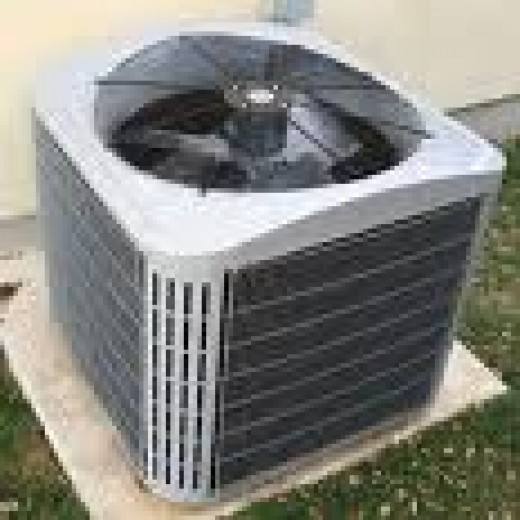
A common modern condenser. This looks like a Carrier product to my eyes.
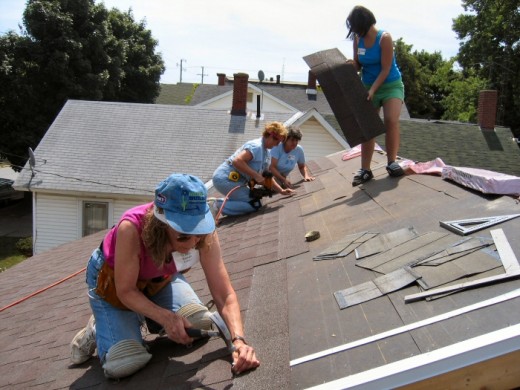
These guys work very hard-but they usually don't know shit about air conditioning.
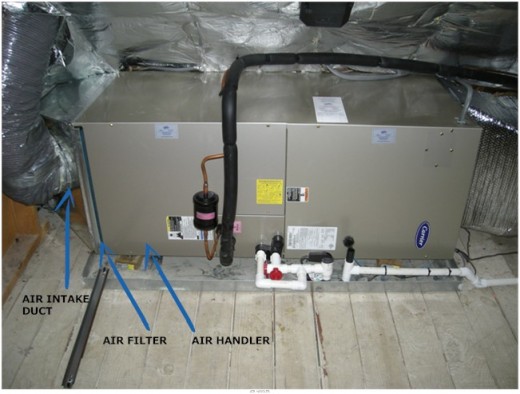
a horizontal air handler or furnace
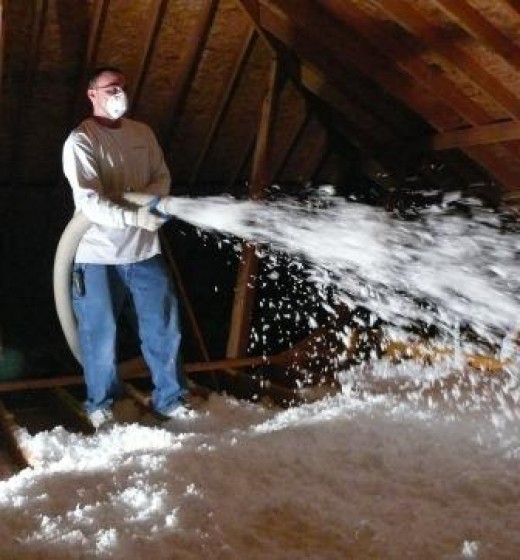
A man spraying in insulation into an attic-make sure he doesn't get any in your emergency drain pan!
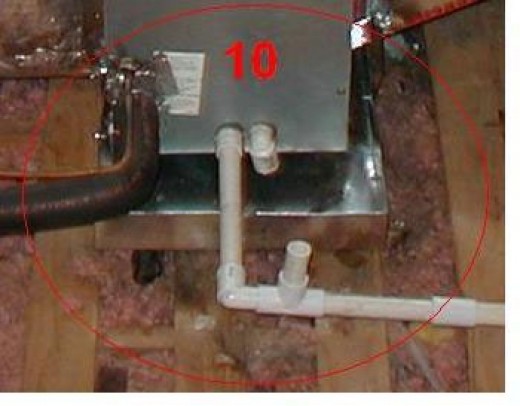
You can clearly see an emergency drain pan at the bottom of this horizontal furnace.
When good upgrades go bad, and suggestions on how to prevent it.
If
you will look at the second picture, you'll see what is obviously a
crew of roofers installing shingles on a house. What does this have to
do with air conditioning, and air conditioning systems? I'll tell
you-twice this Summer I've encountered severe damage to air conditioning
systems done by roofing crews; and all of these incidents were
completely preventable. An ounce of prevention is worth a pound of cure,
they say, and "they" are correct. I think that the odds will dictate
that my chances of educating a roofing contractor or worker here are
rather small, but that my chances of preventing a homeowner from
experiencing some unnecessary misery are much better; and I shall begin
forthwith.
Looking at your condenser you'll notice that there is a fan motor at the top of it. Nothing should EVER be placed on top of your condenser's fan motor EVER without the presence of an HVAC professional ; and only then if the system is turned OFF either at the thermostat, or preferably, .a breaker or disconnect. What on Earth am I talking about? I'll tell you-this Summer a roofing crew covered up the fan motor at one of my customer's houses. They THOUGHT that they were protecting it, and their intentions were to prevent any roofing nails, etc, from falling into it-but the consequences of their actions were completely ruinous to the condenser because they didn't turn it off. What happened was this: The unit was left running without any ability to cool the hot gas(R-22 refrigerant) inside, and this caused the compressor to overheat.
In addition to an overheated compressor, the vertical, soft aluminum fins around the coil were all sucked flat, or shut, thereby preventing air from crossing the coils, and cooling the refrigerant, should the thing ever get the opportunity to run again-which was doubtful, as the compressor had been subject to extreme heat.
*Note*: Residential air conditioning compressors DO have an internal overload in the form of a bi-metal switch, however, there is never any guarantee that this switch will re-set, as the compressor shouldn't ever be subjected to an occasion in which this overload has to be utilized. The older a condenser is-the less likely that the internal overload WILL re-set. The primary factor determining whether or not it will re-set is, and always has been this, the number of times the overload has opened. Sure, the compressor could have been saved in this instance had the damage to the fins around the coil not effectively trashed the unit.
I must admit that the situation described above is surely a rare occurrence, so now I'd like to describe a more common problem. Take a look now, if you will, at the third picture. What you are seeing is a typical air handler/furnace installed in an attic. Look for a long, black thing extending out of the air handler/furnace. Do you see it? Good. What this is is your insulated suction line, which travels from the air handler in the attic all the way to the condenser outside. There is also a smaller, uninsulated line, and it is the hot, high pressure line which travels the same path. Both of these lines are copper, and copper is a soft metal. When you are having new shingles installed on your roof, you need to be aware of these copper lines because on occasion roofing crews inadvertently shoot nails through them, which causes an air conditioning system to loose it's refrigerant charge, usually all of it.
What can you do about this? Well, communication is the key, and I'd suggest that you speak with your roofing contractor before work begins, and ask him to check, and make sure that your "line set," as those two copper lines are called, is safely out of range of nails penetrating the roof. You could also call your air conditioning company of choice, and ask them to come out and make certain that the lines are not positioned against the inside of the roof. Either choice is superior to having your system leak out all of it's refrigerant.
What happens when a system looses it's refrigerant charge? Well, once again-your compressor could overheat, and be ruined. Refrigerant leaks are common-but a leak the size of a roofing nail hole is not, and a leak of that size would drain the system rather quickly.
In the fourth picture down you'll see a man wearing a mask, and spraying something into an attic. What this is is a picture of a contractor spraying in insulation in an attic in an effort to improve the home's energy efficiency. It's a great idea to upgrade your homes insulation, and I highly recommend this; however, there are things that you need to be aware of should you go this route in order to improve the value of your home and/or save electricity over a period of years. In the last picture, the one at the bottom of the group you'll see another instance of an air handler, or furnace installed in an attic. I chose this picture because you can see the emergency drain pan at the bottom, underneath the unit.
What is an emergency drain pan? Well, if your air conditioning system's indoor unit is located in an attic, then you SHOULD have an emergency drain pan underneath it. Your indoor unit has a primary drain pan, of course, and it drains the condensate water which collects in the unit. This water is the humidity that was in the ambient air in your home. Over time any system's primary drain pan, or drain line will become clogged up with "gunk," algae, etc; and when this happens the water will flow out of the unit, and into the emergency pan, should you have one, and hopefully you do. Your primary drain will be piped into your sewer, but your emergency pan will drain out of the side of your roof-and should you notice a small bit of pvc pipe leaking water near the roof of your home-then you've certainly got both a clogged primary drain line or pan, and a functioning emergency drain pan.
*Note*: repairing a clogged primary drain line is an easy fix, and should you ever notice that condensate water is running into your emergency pan, then please call your local HVAC service company, and have them fix the problem. Emergency drain pans are a must, and if you have an attic air handler without one, then it is MOST Highly recommended that you have an emergency pan installed, however, an emergency drain pan is not something that should be allowed to function as the system's drain.
What does this have to do with insulation????? Well, this Summer I had a customer who had recently had insulation sprayed into her attic. The problem with this was that the contractor sprayed insulation into the Lady's emergency drain pan, which clogged it up. When her primary pan became stopped up, water flowed into the emergency pan which was full of insulation-and then the water overflowed onto her ceiling, and soon the tiles collapsed onto her carpet. Had this Lady been out of town, then surely she would have to replace not only her ceiling(below the unit), but also her carpet, and any wood flooring that overflowed condensate water, and was damaged.
Once again, communication is the key-and if you will take the time to speak to your insulation installation guy, and tell him that you are concerned about your air conditioning system's emergency drain pan, then certainly the guy will be cognizant of it, and make every effort to NOT get insulation in it.
I thank anyone who has stayed with me through this whole thing, and I wish you all happy home improvements!
Looking at your condenser you'll notice that there is a fan motor at the top of it. Nothing should EVER be placed on top of your condenser's fan motor EVER without the presence of an HVAC professional ; and only then if the system is turned OFF either at the thermostat, or preferably, .a breaker or disconnect. What on Earth am I talking about? I'll tell you-this Summer a roofing crew covered up the fan motor at one of my customer's houses. They THOUGHT that they were protecting it, and their intentions were to prevent any roofing nails, etc, from falling into it-but the consequences of their actions were completely ruinous to the condenser because they didn't turn it off. What happened was this: The unit was left running without any ability to cool the hot gas(R-22 refrigerant) inside, and this caused the compressor to overheat.
In addition to an overheated compressor, the vertical, soft aluminum fins around the coil were all sucked flat, or shut, thereby preventing air from crossing the coils, and cooling the refrigerant, should the thing ever get the opportunity to run again-which was doubtful, as the compressor had been subject to extreme heat.
*Note*: Residential air conditioning compressors DO have an internal overload in the form of a bi-metal switch, however, there is never any guarantee that this switch will re-set, as the compressor shouldn't ever be subjected to an occasion in which this overload has to be utilized. The older a condenser is-the less likely that the internal overload WILL re-set. The primary factor determining whether or not it will re-set is, and always has been this, the number of times the overload has opened. Sure, the compressor could have been saved in this instance had the damage to the fins around the coil not effectively trashed the unit.
I must admit that the situation described above is surely a rare occurrence, so now I'd like to describe a more common problem. Take a look now, if you will, at the third picture. What you are seeing is a typical air handler/furnace installed in an attic. Look for a long, black thing extending out of the air handler/furnace. Do you see it? Good. What this is is your insulated suction line, which travels from the air handler in the attic all the way to the condenser outside. There is also a smaller, uninsulated line, and it is the hot, high pressure line which travels the same path. Both of these lines are copper, and copper is a soft metal. When you are having new shingles installed on your roof, you need to be aware of these copper lines because on occasion roofing crews inadvertently shoot nails through them, which causes an air conditioning system to loose it's refrigerant charge, usually all of it.
What can you do about this? Well, communication is the key, and I'd suggest that you speak with your roofing contractor before work begins, and ask him to check, and make sure that your "line set," as those two copper lines are called, is safely out of range of nails penetrating the roof. You could also call your air conditioning company of choice, and ask them to come out and make certain that the lines are not positioned against the inside of the roof. Either choice is superior to having your system leak out all of it's refrigerant.
What happens when a system looses it's refrigerant charge? Well, once again-your compressor could overheat, and be ruined. Refrigerant leaks are common-but a leak the size of a roofing nail hole is not, and a leak of that size would drain the system rather quickly.
In the fourth picture down you'll see a man wearing a mask, and spraying something into an attic. What this is is a picture of a contractor spraying in insulation in an attic in an effort to improve the home's energy efficiency. It's a great idea to upgrade your homes insulation, and I highly recommend this; however, there are things that you need to be aware of should you go this route in order to improve the value of your home and/or save electricity over a period of years. In the last picture, the one at the bottom of the group you'll see another instance of an air handler, or furnace installed in an attic. I chose this picture because you can see the emergency drain pan at the bottom, underneath the unit.
What is an emergency drain pan? Well, if your air conditioning system's indoor unit is located in an attic, then you SHOULD have an emergency drain pan underneath it. Your indoor unit has a primary drain pan, of course, and it drains the condensate water which collects in the unit. This water is the humidity that was in the ambient air in your home. Over time any system's primary drain pan, or drain line will become clogged up with "gunk," algae, etc; and when this happens the water will flow out of the unit, and into the emergency pan, should you have one, and hopefully you do. Your primary drain will be piped into your sewer, but your emergency pan will drain out of the side of your roof-and should you notice a small bit of pvc pipe leaking water near the roof of your home-then you've certainly got both a clogged primary drain line or pan, and a functioning emergency drain pan.
*Note*: repairing a clogged primary drain line is an easy fix, and should you ever notice that condensate water is running into your emergency pan, then please call your local HVAC service company, and have them fix the problem. Emergency drain pans are a must, and if you have an attic air handler without one, then it is MOST Highly recommended that you have an emergency pan installed, however, an emergency drain pan is not something that should be allowed to function as the system's drain.
What does this have to do with insulation????? Well, this Summer I had a customer who had recently had insulation sprayed into her attic. The problem with this was that the contractor sprayed insulation into the Lady's emergency drain pan, which clogged it up. When her primary pan became stopped up, water flowed into the emergency pan which was full of insulation-and then the water overflowed onto her ceiling, and soon the tiles collapsed onto her carpet. Had this Lady been out of town, then surely she would have to replace not only her ceiling(below the unit), but also her carpet, and any wood flooring that overflowed condensate water, and was damaged.
Once again, communication is the key-and if you will take the time to speak to your insulation installation guy, and tell him that you are concerned about your air conditioning system's emergency drain pan, then certainly the guy will be cognizant of it, and make every effort to NOT get insulation in it.
I thank anyone who has stayed with me through this whole thing, and I wish you all happy home improvements!
Spring Home Air Conditioning Tune Up Checklist
- Springtime Home Air Conditioning Tune Up Checklist.
Extensive and thorough, but it would be near impossible for my list to be complete. This was written for both homeowners - in order to see that they are getting great service; and as advice to young service technicians.

0 comments:
Post a Comment